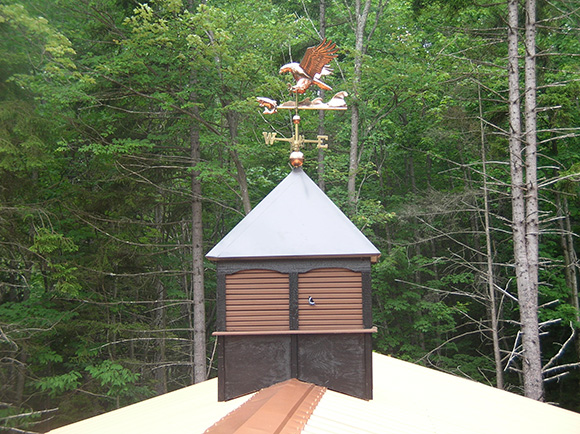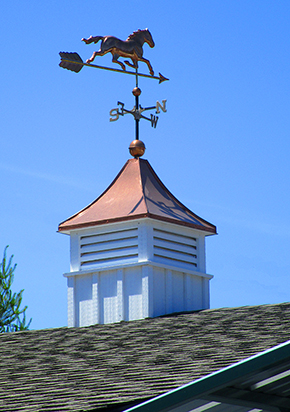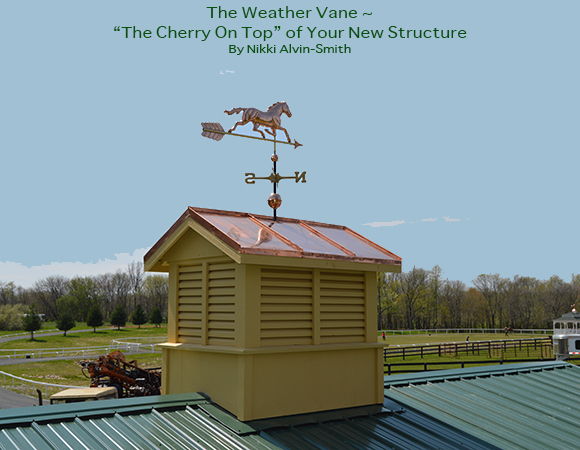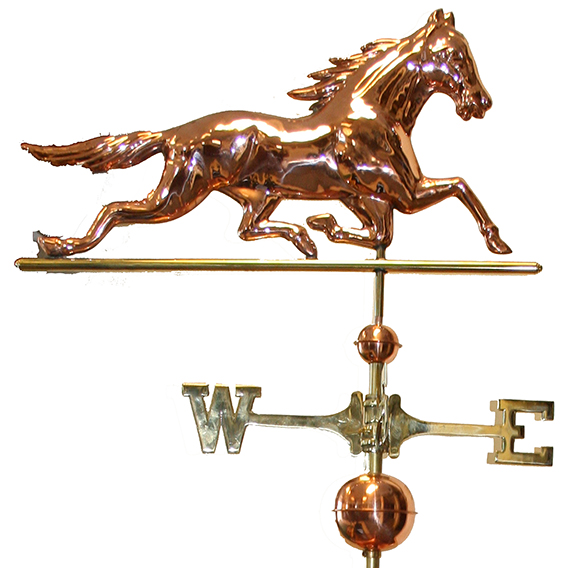The Weather Vane ~ “The Cherry On Top” of Your New Structure
By Nikki Alvin-Smith
In one form or another the weather vane has been around since ancient times. Today its presence may be regarded as more decorative than functional, as we hit our cell phone apps for the latest weather reports and don’t rely on myths or changes in the wind direction to foretell the forecast. A shame really, but it is fun picking out the design you want to place on top of your new structure. Whether it is a running horse inspired by the 19th Century artists Currier and Ives, the traditional cock (weathercock), a religious symbol for the Catholic church, or something other, this is an insignia of your farm or property that you can share for all to see.

As the weather vane was a device for weather forecasting, it is not surprising that farmers were the ones that heavily utilized its service. We all know how much farmers rely on the weather for crop planting and harvesting and the wind is the element that brings us weather. The ball that is often set below the weather vane was thought to dispel lightening from the top of tall buildings, and as barns were usually the largest structure on a farmer’s property the weathervane was usually placed atop the barn.
We may not believe that the winds have divine powers the way the Greeks did back in 48 B.C. and erect weather vanes depicting the Gods, but our ancestors such as the Vikings, the great sea-farers of the world, found it useful for their voyages to use the weather vane as a compass and their mounting on Viking ships was common. So it is no surprise that the word “vane” is of Anglo-Saxon heritage, a variance of “fane” which translates in English to flag.
It wasn’t long after that the medieval noblemen adopted the weather vane and determined that rather than fabric, the vane could be made of metal for longevity. A wealth of coat of arm designs adorned the weathervane on castles, mansions and houses across Europe. The architectural delights of the design aside, the function of the weather vane can still be useful in weather prediction.
Whatever you are building, the tradition of adding a weather vane is not just ‘vanity’ it serves a valuable purpose as an indicator or changes in the weather.
When the North wind blows we all know what that means ~ and changes in the wind direction can be harbingers of changes in the weather.
The Weather Vane Needs a Correct Install
To properly place a weather vane you must know your points of the compass, North, South, East and West. The vane must swivel freely, and while all vanes do not incorporate arrows, most are composed of three parts, the vane, the mast and the base. The vertical mast does not move. The positioning of the compass points must be fixed and be accurately positioned to reflect the right direction i.e. North will point to North etc. The vane will swivel toward the direction of the wind indicating the wind direction.
 Regularly they are set above cupolas on a building, but the cupola must be constructed or adapted to the type of weather vane to be used. There are three major types of masts: a threaded mast is the strongest and used on pitched roofs or cupolas; an adjustable clutch base which can be adjusted to accommodate any roof pitch and the fixed base.
Regularly they are set above cupolas on a building, but the cupola must be constructed or adapted to the type of weather vane to be used. There are three major types of masts: a threaded mast is the strongest and used on pitched roofs or cupolas; an adjustable clutch base which can be adjusted to accommodate any roof pitch and the fixed base.
At our farm we purchased a large indoor arena from a leading Midwest company, and the design included three cupolas and three weather vanes. The weather vanes were “free” and thrown into the price of the building. Needless to say their insignia was that of the building manufacturer. Keen advertising for sure! However, within two months two of the vanes were tipping in various directions and within a few more days they had glided gracefully down the tin roof and were deposited on the grass below. Thankfully they did not damage anyone or any animal during their fall and we were not riding horses in the building at the time so no harm was done. But it did stress the importance of having the female rod that receives the mast properly installed in the cupola and having someone knowledgeable do the installation. None of us want to scramble up the roof to make amends to a poorly done job.
Which Direction To Take
When it comes to building any structure, it is a good idea to utilize the services of someone experienced that is also flexible about your individual design needs and wants. Whether you want to save money by having a modular garage built, purchase your ‘instant’ prefabricated dream horse barn with a ‘to the penny’ quote, or have smaller structure needs such as a pretty but functional chicken coop or kennel, all structures can be enhanced by the inclusion of a weather vane.
We spoke with Jill Siragusa, Marketing Director at leading modular builder Horizon Structures L.L.C. to garner some sage advice on the cupola and weather vane options folks should know about:
“We actually just posted a super blog about cupolas and how important they are for ventilation and animal health. The variance in sizes of cupolas and their shapes and the addition of a beautiful copper weather vane can really make a building stand out and enhance your enjoyment of viewing the building. As we are often viewing our barns and buildings from our house, and certainly visitors and neighbors get to see plenty of them, it’s great to balance the function of a cupola with personal expression of a wonderfully designed weather vane. At Horizon Structures we offer budget friendly options for both. We can advise you on the correct size for the structure of both components, and of course our team are experts at their build and installation,” explained Siragusa.
If you are ready to set sail on your next building project, give the experts at Horizon Structures a call at 1 888 447 4337. They have answers to questions you didn’t know you needed to ask, and provide structures for all types of uses including commercial projects across multiple functions.




